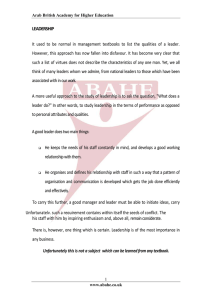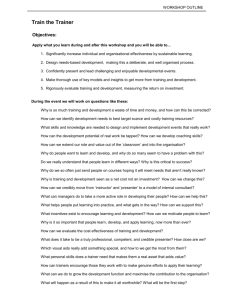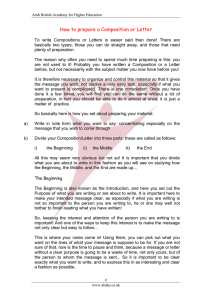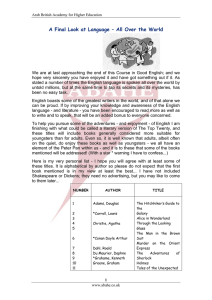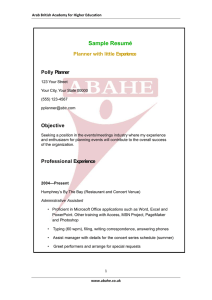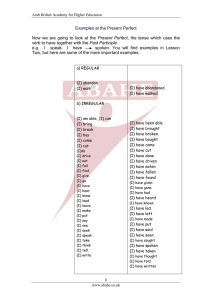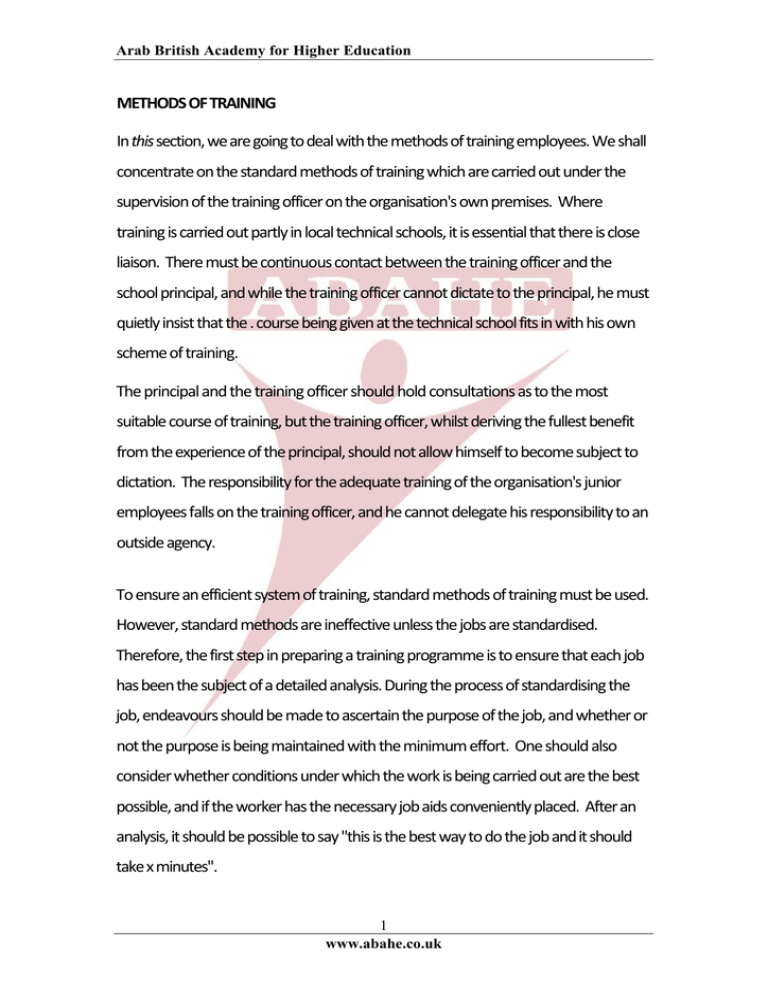
Arab British Academy for Higher Education
METHODS OF TRAINING In this section, we are going to deal with the methods of training employees. We shall concentrate on the standard methods of training which are carried out under the supervision of the training officer on the organisation's own premises. Where training is carried out partly in local technical schools, it is essential that there is close liaison. There must be continuous contact between the training officer and the school principal, and while the training officer cannot dictate to the principal, he must quietly insist that the . course being given at the technical school fits in with his own scheme of training. The principal and the training officer should hold consultations as to the most suitable course of training, but the training officer, whilst deriving the fullest benefit from the experience of the principal, should not allow himself to become subject to dictation. The responsibility for the adequate training of the organisation's junior employees falls on the training officer, and he cannot delegate his responsibility to an outside agency. To ensure an efficient system of training, standard methods of training must be used. However, standard methods are ineffective unless the jobs are standardised. Therefore, the first step in preparing a training programme is to ensure that each job has been the subject of a detailed analysis. During the process of standardising the job, endeavours should be made to ascertain the purpose of the job, and whether or not the purpose is being maintained with the minimum effort. One should also consider whether conditions under which the work is being carried out are the best possible, and if the worker has the necessary job aids conveniently placed. After an analysis, it should be possible to say "this is the best way to do the job and it should take x minutes". 1
www.abahe.co.uk
Arab British Academy for Higher Education
After the job has been standardised, it is most important that the procedure be set out in writing in great detail. Each job should be given a title. Details of the job aids and their position in relation to the job should be stated. Then each trainer should be given a copy of the Training Handbook, which should contain the standard methods for performing each job. These methods should be followed on all occasions. Existing employees must be trained in the standardised methods when they are first introduced, so that the methods followed by the trainee will be identical to those used throughout the organisation. There should be no deviation from standard practice. A bright employee may find a method which will speed up his particular job, but if he is a member of a team he may upset the rhythm of the process if he acts as an individual. The four main outcomes resulting from a departure from standard practice are given below: (a) Lack of Uniformity in dealing with the work Adam Smith in his monumental work "The Wealth of Nations", was perhaps the first economist to stress the advantages of specialisation. It has been pointed out that, whilst most of us can fold a newspaper fairly quickly, a man who is doing the job continually can do it at a faster rate. That is one of the principles underlying the advantages of standard performance. A man who is doing the same job, in the same way, every day, will become more adept than if he were not following the standard method. You may well ask, "What of the unusual job which may occur?" The answer to that is that you must have a skilled person, well versed in standard practices, but sufficiently versatile to depart from the standard to deal with those jobs which require special 2
www.abahe.co.uk
Arab British Academy for Higher Education
attention and yet derive the benefits of standard practice. Such a person would be outside the standard routine of the department. (b) Lack of Cohesion in standard routines If the path of a certain document is being traced, it may be difficult to locate it if a worker has taken a "short cut" from the standard method, and by doing so, eliminated one or more steps in the standard routine. Much delay may be caused through all and sundry having to stop their work in order to answer questions. (c) Confusion If a newcomer finds that the older employees are not using the standard method, he will become confused, since, according to the trainer the standard method is the most efficient way of doing the job. Supervisors should insist upon standard methods being used, and trainers should make periodic checks in support of the supervisors. (d)
Optimum results unobtainable It has already been said that the standard methods are arrived at after a period of prolonged study and experiment, in which the workers themselves have been invited to co‐operate. Therefore, it must have been proved that the standard methods are capable of producing the best results. Those workers who, after being apprised of the advantages of standard methods, seek to follow their own accustomed methods, are jeopardising the official training scheme. They should be made to toe the line, otherwise there will be a drag on production. When training, all instructions should be as individualistic as possible, and no training group should exceed six in number. Each individual has his particular problems which should be dealt with as they arise. This is not possible with large groups. V/hen the groups break up and the trainees go on to the job, 3
www.abahe.co.uk
Arab British Academy for Higher Education
each trainee should have a sponsor who will keep an eye on his progress and help him with any difficulties which may arise. It is sometimes said that teachers are born, not made. This is true to a large extent. Some people are more adept at imparting knowledge to others and getting a response , while other would‐be teachers simply waste their own time and that of their pupils. Therefore, the personnel manager ust exercise great care in selecting his trainers. The essential qualities and qualifications of a good teacher are as follows: (a) Knowledge of the subject This supposes an all‐round knowledge of the subject, both from a practical and theoretical point of view. The teacher must have been given a good practical training in the subject, and must have passed the relevant examinations so as to obtain the desired professional status. It is also pre‐supposed that the trainer has the ability to learn and to pass on to others, the standard methods of the organisation. (b) Teaching ability It is possible to know a subject thoroughly and yet be unable to explain it to others. Similarly, it is possible to have expert craftsmen who find it extremely difficult to tell others how the job is done. Such people have a place in an organisation for their performance of the function, but they are not teachers. The job of the personnel manager is to find people who are able to pass on their skills to others, by means of speech and example. (c) Patience. 4
www.abahe.co.uk
Arab British Academy for Higher Education
One of the biggest discouragements to a teacher is in finding that • after weeks of teaching, a pupil has not grasped the points of his instructions, or worse, that he has forgotten them. The teacher can become upset, but he must get a tight grip on himself and start all over again. The quality of patience in a trainer is no less important than the subject knowledge and the ability to teach. (d) Subject or job interest One of the most desirable attributes in a trainer is enthusiasm. If he is keen on the job, if he is convinced that a particular job is one of the finest obtainable, if he can evoke a comparable enthusiasm in the trainees, then his task of training is half done. Nothing is as infectious as enthusiasm, and if the trainer can instil enthusiasm for the job into the trainee from the outset, then he will have already served his organisation well. All Rights Reserved © Arab British Academy for Higher Education
5
www.abahe.co.uk

